Introduction
Welcome to the world of Solid State Drives (SSDs)! In the realm of computer storage, SSDs have revolutionized the way data is stored and accessed. They have quickly become a popular choice for many due to their superior speed, reliability, and durability. However, to truly optimize the performance and prolong the lifespan of an SSD, a technique called SSD Over Provisioning is often employed.
SSD Over Provisioning is a method that involves allocating a portion of the SSD’s storage capacity for purposes other than user data storage. This reserved space helps to enhance the drive’s performance and overall efficiency. By implementing Over Provisioning, SSDs can mitigate issues such as reduced performance, degraded write endurance, and slow performance due to static data.
Over Provisioning is essentially like having a secret stash of extra storage space that is hidden from the user. This extra space is used to improve the SSD’s performance and maintain its lifespan. As a result, an SSD with Over Provisioning offers improved write speed, longer durability, and ultimately a better overall user experience.
In this article, we will delve into the world of SSD Over Provisioning. We will explore the definition of Over Provisioning, its benefits, how it works, different types of Over Provisioning, recommended Over Provisioning ratios, how to implement Over Provisioning on an SSD, its impact on performance and lifespan, and other essential considerations to keep in mind. So let’s dive in and discover the secrets behind SSD Over Provisioning!
Definition of SSD Over Provisioning
SSD Over Provisioning, also known as OP, is a technique used in Solid State Drives to allocate a specific amount of storage space that is not accessible to the user for data storage purposes. This reserved space is utilized by the SSD’s controller to perform various internal tasks, such as wear leveling, garbage collection, and maintaining performance consistency.
Over Provisioning is implemented at the factory level during the manufacturing process, where a certain percentage of the drive’s total capacity is set aside. This additional space acts as a buffer and helps to maintain the drive’s overall performance and lifespan. The actual overprovisioned space is not visible to the user, as it is not included in the drive’s advertised capacity.
The primary purpose of Over Provisioning is to improve the SSD’s performance and endurance characteristics. By having extra storage space available, the SSD’s controller can effectively distribute the data writing and erasing operations across a larger number of memory cells. This helps to minimize the impact of sustained write operations and reduces the chance of data corruption or performance slowdowns over time.
Additionally, Over Provisioning allows the SSD’s controller to perform background tasks, such as garbage collection, more efficiently. Garbage collection is the process of reclaiming and consolidating blocks of memory that are no longer in use. By having dedicated overprovisioned space, the controller can perform these tasks without affecting the drive’s overall performance during regular usage.
Overall, SSD Over Provisioning provides the SSD with additional resources for internal management, ensuring optimal performance, improved endurance, and increased longevity. It is a crucial technique that plays a significant role in maximizing the capabilities of SSDs and delivering a smoother and more reliable storage experience.
Benefits of SSD Over Provisioning
Implementing SSD Over Provisioning offers several significant benefits that enhance the performance, endurance, and lifespan of Solid State Drives. Let’s explore some of the key advantages of utilizing Over Provisioning in an SSD:
- Improved Performance: By allocating a portion of the SSD’s capacity for internal tasks, Over Provisioning allows the drive’s controller to optimize data management operations effectively. This leads to faster write and erase operations, reduced latency, and improved overall performance.
- Enhanced Endurance: SSDs have a limited number of program/erase cycles, also known as P/E cycles, before their memory cells begin to wear out. With Over Provisioning, the allocation of extra memory cells helps distribute the wear more evenly, extending the drive’s overall lifespan and improving its endurance.
- Increase in Write Speeds: Over Provisioning enables faster write speeds by providing the SSD’s controller with more available memory cells to use for write operations. This prevents the drive from becoming congested with static data and helps maintain consistently high write performance.
- Improved Garbage Collection: Over Provisioning provides the SSD’s controller with additional space to perform efficient garbage collection, which helps reclaim unused memory blocks. This results in more effective management of data and prevents performance degradation due to fragmented or occupied memory cells.
- Consistent Performance: Over Provisioning prevents the SSD from becoming “full” in terms of data storage, thus ensuring that performance remains consistent even when the drive is nearing its maximum capacity. This is particularly important for SSDs used in demanding environments or for high-intensity workloads.
- Reliable Data Integrity: By optimizing wear leveling and minimizing write amplification, Over Provisioning helps maintain the integrity of stored data. This reduces the risk of data corruption or loss, ensuring that files and information remain safe and accessible over time.
As you can see, Over Provisioning offers numerous benefits that significantly improve the functionality and reliability of SSDs. These advantages make it an essential technique for users seeking optimal performance, durability, and a longer lifespan for their Solid State Drives.
How SSD Over Provisioning Works
To understand how SSD Over Provisioning works, let’s take a closer look at the internal workings of a Solid State Drive. An SSD is comprised of several NAND flash memory chips, a controller, and firmware that manages the storage operations. SSD Over Provisioning utilizes the controller and firmware to reserve a specific portion of the drive’s capacity for internal use.
When an SSD is overprovisioned, a certain percentage of the storage space is designated for tasks such as wear leveling, garbage collection, and background maintenance operations. This overprovisioned space is invisible to the user and is not included in the advertised drive capacity.
The primary purpose of Over Provisioning is to alleviate the limitations and challenges associated with NAND flash memory technology. NAND flash cells have a finite lifespan, referred to as program/erase (P/E) cycles. Each time data is written to a cell, it undergoes a certain number of P/E cycles before it begins to degrade.
Over Provisioning mitigates the wear and tear on NAND flash cells by ensuring that not all of the available memory cells are used for data storage. By leaving a portion of the cells unused, the SSD’s controller can dynamically distribute the write and erase operations across a larger number of cells, thus reducing the wear on individual cells and extending the overall lifespan of the SSD.
Additionally, Over Provisioning enables the SSD’s controller to perform background tasks more efficiently. These tasks include garbage collection, which helps to consolidate and free up space in memory cells that are no longer in use. With Over Provisioning, the controller has dedicated space to perform these operations without impacting the drive’s overall performance during regular usage.
The exact method of implementing Over Provisioning can vary depending on the SSD and its firmware. Some drives allow users to manually set the level of Over Provisioning, while others have fixed amounts set by the manufacturer. Regardless of the method, the benefits of Over Provisioning remain consistent across all SSDs.
By utilizing Over Provisioning, SSDs can deliver enhanced performance, improved endurance, and increased reliability. It optimizes the use of NAND flash memory cells, reduces write amplification, and ensures the efficient management of data. In the next section, we will explore the different types of Over Provisioning and the recommended ratios for optimal SSD performance and longevity.
Types of SSD Over Provisioning
SSD Over Provisioning can be categorized into two main types: system-level Over Provisioning and user-level Over Provisioning. Each type has its own unique characteristics and methods of implementation. Let’s explore these types in more detail:
1. System-Level Over Provisioning:
System-Level Over Provisioning refers to the allocation of a fixed amount of storage space by the SSD manufacturer during the manufacturing process. This reserved space is not accessible to the user and is solely utilized by the drive’s controller for internal functions such as wear leveling and garbage collection. The amount of overprovisioned space in system-level Over Provisioning varies depending on the SSD model and manufacturer, but it is typically around 7-28% of the total drive capacity.
2. User-Level Over Provisioning:
User-Level Over Provisioning, as the name suggests, allows users to manually allocate a portion of the SSD’s storage space for Over Provisioning. This can be done during the initial setup of the drive or through SSD management software provided by the manufacturer. User-Level Over Provisioning provides flexibility to users, as they can choose the amount of overprovisioned space based on their specific needs and usage requirements.
It is important to note that not all SSDs support user-level Over Provisioning, and the method of implementation can vary between different manufacturers and models. Some SSDs may offer a straightforward option to allocate a specific percentage of the drive for Over Provisioning, while others may require advanced settings in the SSD management software.
Both system-level and user-level Over Provisioning provide benefits in terms of improved performance, increased endurance, and enhanced data management. System-level Over Provisioning is often already applied to SSDs by the manufacturer, ensuring a baseline level of performance optimization. User-level Over Provisioning allows for further customization and optimization based on individual requirements.
In the next section, we will discuss the recommended Over Provisioning ratios to achieve optimal SSD performance and longevity.
Recommended Over Provisioning Ratios
When it comes to Over Provisioning an SSD, finding the right balance is crucial. Allocating too little or too much space for Over Provisioning can impact performance and overall drive efficiency. While the optimal Over Provisioning ratio may vary depending on the specific SSD model and usage scenario, there are some general guidelines to consider.
For system-level Over Provisioning, which is already allocated by the SSD manufacturer, it is typically recommended to leave it as is and not modify it. Manufacturers carefully determine the amount of Over Provisioning to ensure optimal performance and endurance for their drives.
For user-level Over Provisioning, pinpointing an exact recommended ratio can be more challenging, as it depends on factors such as the SSD’s capacity, usage requirements, and the user’s specific needs. However, a common guideline is to allocate 10-20% of the drive’s total capacity for Over Provisioning.
It’s essential to consider the trade-offs when determining the Over Provisioning ratio. Allocating a higher percentage of the drive for Over Provisioning can provide enhanced performance and endurance, but it will reduce the available storage space for user data. On the other hand, allocating a lower percentage may offer more storage space but could result in reduced drive performance and lifespan.
Additionally, it’s important to note that Over Provisioning is typically more beneficial for smaller SSDs with lower capacities. Larger capacity SSDs already have more inherent overprovisioned space due to their higher total capacity, so allocating additional Over Provisioning may not yield significant performance improvements.
It’s recommended to consult the SSD manufacturer’s guidelines, documentation, or support resources for specific recommendations on Over Provisioning ratios for their drives. Furthermore, SSD management software provided by the manufacturer may offer insights and tools to adjust the Over Provisioning ratio based on individual needs.
Finding the right Over Provisioning ratio may involve some trial and error, as it depends on the specific use case and workload. Monitoring the SSD’s performance and endurance over time can help fine-tune the Over Provisioning ratio for optimal results.
In the next section, we will explore the steps involved in implementing Over Provisioning on an SSD.
How to Over Provision an SSD
Over Provisioning an SSD can be done through user-level settings and adjustments. The specific method may vary depending on the SSD model and the software provided by the manufacturer. Here are the general steps to follow when implementing Over Provisioning on an SSD:
- Backup your data: Before making any changes to your SSD’s settings, it is crucial to create a backup of all your important data. This ensures that your data remains safe in case of any unexpected issues during the Over Provisioning process.
- Check manufacturer guidelines: Review the SSD manufacturer’s documentation, support resources, or SSD management software for any specific guidelines or recommendations regarding Over Provisioning. This information will help you understand which settings are available for your SSD and how to properly adjust them.
- Access the SSD management software: Some SSDs come with dedicated management software provided by the manufacturer. Locate and launch this software to access the settings related to Over Provisioning.
- Allocate Over Provisioning space: Once you are in the SSD management software, look for options related to Over Provisioning or reserved space. Choose the desired amount of storage space you want to allocate for Over Provisioning. As mentioned earlier, a recommended range is typically 10-20% of the total drive capacity. Follow any additional prompts or instructions provided by the software.
- Confirm and apply changes: Review the changes you have made and confirm that you want to apply them. The software will then adjust the SSD’s settings accordingly and allocate the designated storage space for Over Provisioning.
- Monitor performance: After implementing Over Provisioning, it’s important to monitor the SSD’s performance over time. Keep an eye on benchmarks, drive health, and other performance indicators to ensure that the Over Provisioning is effectively enhancing the SSD’s performance and endurance.
It’s crucial to note that the steps mentioned above are general guidelines. The exact process may differ depending on the SSD model and the software provided by the manufacturer. Always refer to the manufacturer’s documentation and support resources for precise instructions tailored to your SSD.
In the next section, we will discuss the impact of Over Provisioning on SSD performance and lifespan.
Impact of Over Provisioning on SSD Performance and Lifespan
Over Provisioning plays a significant role in shaping the performance and lifespan of Solid State Drives (SSDs). Here, we will explore the impact of Over Provisioning on these two crucial aspects of SSD functionality:
Performance:
Over Provisioning has a positive impact on SSD performance across various parameters:
- Write Speed: By allocating extra space for Over Provisioning, write speeds of the SSD can be improved. This allows for faster and more efficient data transfer, resulting in snappier performance.
- Wear Leveling: Over Provisioning helps distribute data writes across a larger pool of memory cells. This enables better wear leveling, preventing certain cells from wearing out faster than others and reducing the risk of performance degradation over time.
- Garbage Collection: The availability of Over Provisioning space allows the SSD’s garbage collection process to work effectively. It helps to consolidate and free up blocks of memory that are no longer in use, reducing write amplification and maintaining optimal performance.
- Endurance: By reducing write amplification and evenly distributing write operations, Over Provisioning can extend the endurance of the SSD. This means that the drive can sustain more write cycles before reaching its wear limit.
Lifespan:
Over Provisioning has a direct impact on the lifespan of an SSD:
- Wear Leveling: By leveraging Over Provisioning, the SSD’s controller can distribute writes more evenly across a larger number of memory cells. This helps to minimize the wear on individual cells, resulting in an extended lifespan for the SSD.
- Reduced Write Amplification: Over Provisioning reduces write amplification, which occurs when the SSD’s controller needs to write more data than requested. By minimizing write amplification, Over Provisioning helps to reduce the strain on the SSD’s memory cells, ultimately contributing to a longer lifespan.
- Efficient Garbage Collection: Over Provisioning provides the SSD’s controller with dedicated space for garbage collection tasks. This allows for efficient cleaning and consolidation of memory blocks, maintaining optimal performance and extending the lifespan of the SSD.
- Endurance: By minimizing write amplification and promoting wear leveling, Over Provisioning ensures that the SSD can sustain a greater number of write cycles. This results in a prolonged lifespan, making the drive more durable and reliable over time.
It’s important to note that Over Provisioning does not guarantee an infinite lifespan for an SSD. The SSD will eventually reach its maximum write limits even with Over Provisioning in place. However, Over Provisioning helps to optimize performance, reduce wear, and extend the overall lifespan of the drive.
In the next section, we will discuss other considerations to keep in mind when it comes to SSD Over Provisioning.
Other Considerations for SSD Over Provisioning
While SSD Over Provisioning offers several benefits, there are a few additional considerations to keep in mind when implementing this technique:
1. Storage Space:
Over Provisioning reduces the available storage space on the SSD. It’s essential to consider the amount of space you require for your data storage needs and factor that into your decision when determining the Over Provisioning ratio. Ensuring you have sufficient storage space is essential to avoid running out of capacity.
2. Trim Support:
Trim is a command that helps the SSD’s controller efficiently manage unused data blocks. It is crucial to ensure that the operating system and system software support Trim, as it works in conjunction with Over Provisioning to maintain optimal performance and longevity. Regularly enabling Trim on your system is recommended.
3. SSD Health Monitoring:
Implementing Over Provisioning may affect the way SSD health monitoring tools report the drive’s status. Some tools may not accurately reflect the total capacity or available storage space due to the allocation of Over Provisioning. It’s important to verify and interpret the health monitoring reports accordingly.
4. Compatibility:
Not all SSDs support user-level Over Provisioning. It’s crucial to check the specifications and documentation provided by the manufacturer to determine if your SSD allows for user adjustments. In cases where the SSD does not support user-level Over Provisioning, the system-level Over Provisioning implemented by the manufacturer will still offer the benefits discussed.
5. Data Security:
When implementing Over Provisioning, ensure that all sensitive or important data is securely backed up. While Over Provisioning itself does not delete any data, any changes made to the SSD’s settings or partitions can potentially result in data loss if not performed correctly. Taking appropriate data backup measures is crucial to safeguard your valuable files and information.
By considering these factors and taking the necessary precautions, you can effectively implement Over Provisioning on your SSD while ensuring the best balance between performance, capacity, and data security. A well-managed SSD with Over Provisioning can offer significant advantages in terms of speed, endurance, and lifespan.
Conclusion
Solid State Drives (SSDs) have taken the computer storage industry by storm, offering fast and reliable data storage solutions. SSD Over Provisioning is a technique that allows users to optimize the performance and longevity of their SSDs by allocating a portion of the drive’s capacity for internal tasks. By implementing Over Provisioning, SSDs can leverage reserved space for wear leveling, garbage collection, and other maintenance operations. This results in improved performance, increased endurance, and enhanced data management.
System-level Over Provisioning and user-level Over Provisioning are the two main types of Over Provisioning. The amount of Over Provisioning space allocated can have a significant impact on SSD performance and lifespan. It is generally recommended to allocate 10-20% of the drive’s total capacity for user-level Over Provisioning.
Over Provisioning provides multiple benefits, including improved write speeds, enhanced endurance, consistent performance, and reliable data integrity. It allows for better wear leveling, reduces write amplification, and optimizes garbage collection, resulting in a longer-lasting and higher-performing SSD.
When implementing Over Provisioning, it is crucial to consider factors such as available storage space, Trim support, SSD health monitoring, compatibility, and data security. By taking these considerations into account and following manufacturer guidelines, users can ensure a successful Over Provisioning configuration.
SSD Over Provisioning is a powerful technique that enhances the performance and prolongs the lifespan of SSDs. It is an essential tool for users who seek peak performance, durability, and reliability from their Solid State Drives. By optimizing the allocation of storage space and maximizing the capabilities of NAND flash memory, Over Provisioning enables SSDs to deliver exceptional performance, endurance, and longevity for a wide range of applications and workloads.

























